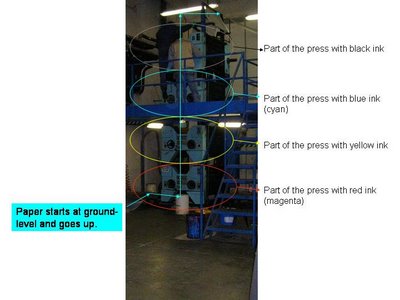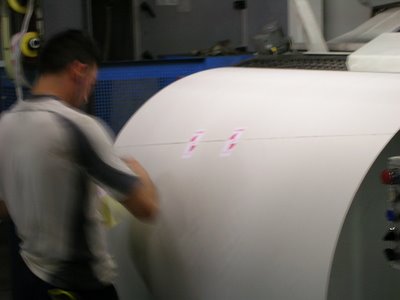How to print a full color newspaper page.
To print a full color page in a newspaper (or in a high volume magazine) it is important to know that all colors can be broken down into a combination of 4 basic colors. The four basic colors are magenta (red), yellow, blue (cyan) and black. By mixing these basic colors all other colors can be created (for example: blue + yellow = green). A newspaper press consists of towers carrying those 4 basic colors. The colors are actually mixed on the paper. It is a chemical process that takes place while the paper is running over the printing press. In the photo example below the paper receives first the red ink, then the yellow, then the blue and finally the black ink.

 In this picture the paper (or web) is fed sideways to the press. The paper actually runs under the feet of the printer, makes a turn of 90 degrees under his feet and goes up through the tower the man in the picture is touching. The man (the printer) is working at the lowest part of the tower, where -in this case- the red ink will be put on the paper.
In this picture the paper (or web) is fed sideways to the press. The paper actually runs under the feet of the printer, makes a turn of 90 degrees under his feet and goes up through the tower the man in the picture is touching. The man (the printer) is working at the lowest part of the tower, where -in this case- the red ink will be put on the paper. At the lower part of the tower the red ink somehow has to reach the paper. Therefore the red ink will be transfered to an aluminum plate first (details of this process -the offset printing process- will be explained in a later post). From the plate the ink will be transfered to a blanket. From the blanket the ink will finally be transfered to the paper.
At the lower part of the tower the red ink somehow has to reach the paper. Therefore the red ink will be transfered to an aluminum plate first (details of this process -the offset printing process- will be explained in a later post). From the plate the ink will be transfered to a blanket. From the blanket the ink will finally be transfered to the paper.
 By manipulating little valves the printer adjusts the volume of ink he wants to cover the paper with. Every valve corresponds with a certain region on the paper where it will transfer the ink to. The regions are marked with blue lines on the picture.
By manipulating little valves the printer adjusts the volume of ink he wants to cover the paper with. Every valve corresponds with a certain region on the paper where it will transfer the ink to. The regions are marked with blue lines on the picture.

 The red ink is visible on the paper. The paper moves upwards to the next colorsection in the tower.
The red ink is visible on the paper. The paper moves upwards to the next colorsection in the tower.
 After the red ink tray, the paper passes the yellow ink tray. As from the moment the yellow ink lands on top of the red ink on the paper it will start to mix and create other colors (all kind of oranges).
After the red ink tray, the paper passes the yellow ink tray. As from the moment the yellow ink lands on top of the red ink on the paper it will start to mix and create other colors (all kind of oranges).
 Red and yellow are clearly visible on the paper.
Red and yellow are clearly visible on the paper.
 After the red (or magenta) ink tray and the yellow ink tray the paper passes the blue (or cyan) ink tray. Red, yellow and blue start to blend, ultimately creating other colors on the paper.
After the red (or magenta) ink tray and the yellow ink tray the paper passes the blue (or cyan) ink tray. Red, yellow and blue start to blend, ultimately creating other colors on the paper.
 Finally the paper passes the black ink tray.
Finally the paper passes the black ink tray.
 Now all 4 basic colors are on the paper blending into all possible other colors imaginable. A newspaper press is typically a 'cold set' press meaning that the paper will dry immediately while it is running over the press. (A magazine press would be typically a heat set press, the paper passes an oven to be heated).
Now all 4 basic colors are on the paper blending into all possible other colors imaginable. A newspaper press is typically a 'cold set' press meaning that the paper will dry immediately while it is running over the press. (A magazine press would be typically a heat set press, the paper passes an oven to be heated).
 Fullcolor pages running over the press.
Fullcolor pages running over the press.




















